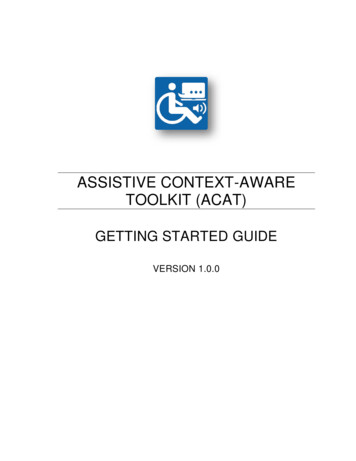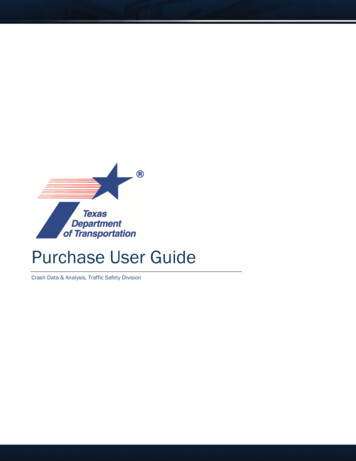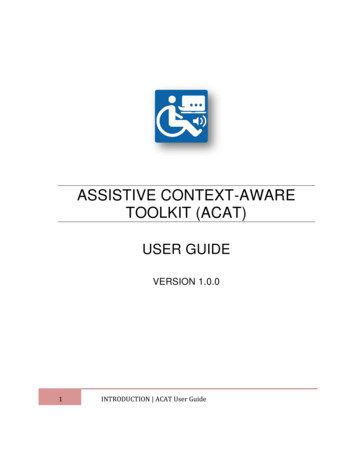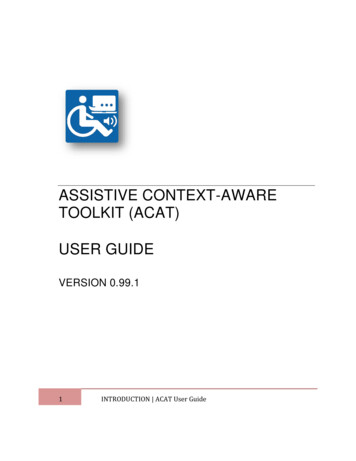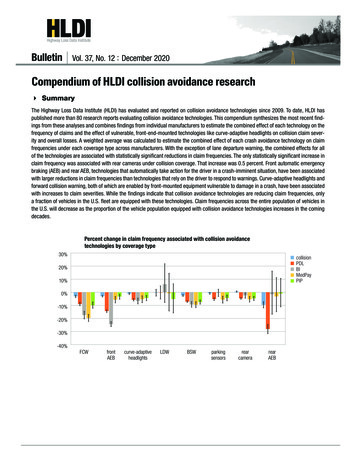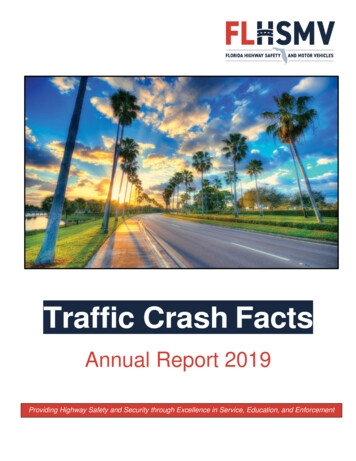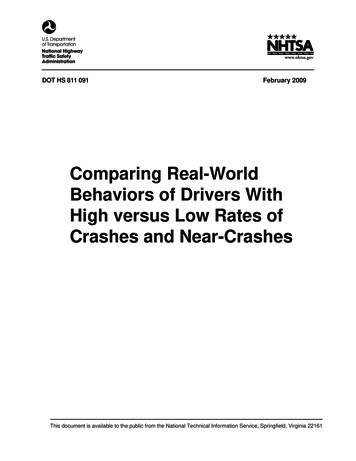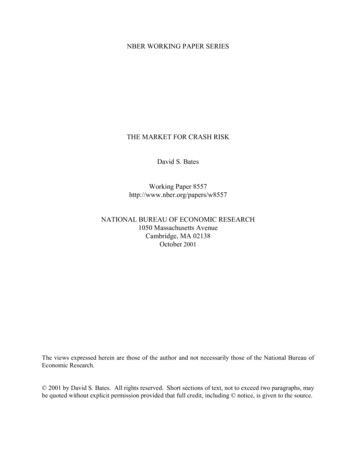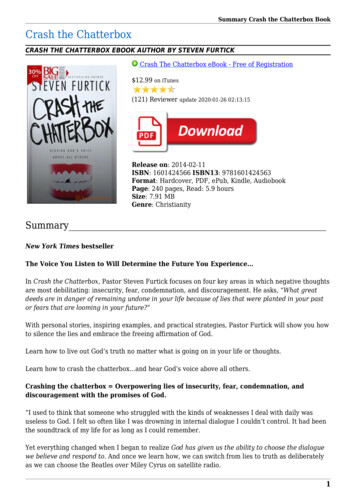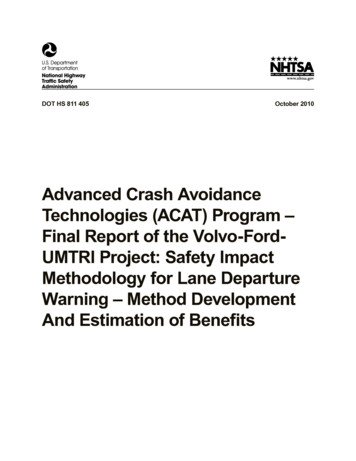
Transcription
DOT HS 811 405October 2010Advanced Crash AvoidanceTechnologies (ACAT) Program –Final Report of the Volvo-FordUMTRI Project: Safety ImpactMethodology for Lane DepartureWarning – Method DevelopmentAnd Estimation of Benefits
DISCLAIMERThis publication is distributed by the U.S. Department of Transportation, National HighwayTraffic Safety Administration, in the interest of information exchange. The opinions, findings,and conclusions expressed in this publication are those of the authors and not necessarily thoseof the Department of Transportation or the National Highway Traffic Safety Administration.The United States Government assumes no liability for its contents or use thereof. If trade names,manufacturers’ names, or specific products are mentioned, it is because they are consideredessential to the object of the publication and should not be construed as an endorsement. TheUnited States Government does not endorse products or manufacturers.
Technical Documentation Page1. Report No.2. Government Accession No.DOT HS 811 4054. Title and SubtitleAdvanced Crash Avoidance Technologies (ACAT) Program – FinalReport of the Volvo‐Ford‐UMTRI Project: Safety ImpactMethodology for Lane Departure Warning – Method Developmentand Estimation of Benefits7. AuthorsGordon, T., Sardar, H., Blower, D., Ljung Aust, M., Bareket, Z.,Barnes, M., Blankespoor, A., Isaksson‐Hellman, I., Ivarsson, J., Juhas,B., Nobukawa, K., and Theander, H.9. Performing Organization Name and AddressVolvo, Ford, UMTRIFord Motor Company, 2101 Village Road, PO Box 2053, Dearborn MI48121‐205312. Sponsoring Agency Name and AddressUSDOT/National Highway Traffic Safety AdministrationOffice of Human Vehicle Performance Research1200 New Jersey Avenue, SE,Washington, DC 205903. Recipient’s Catalog No.5. Report DateOctober 20106. Performing Organization Code8. Performing Organization Report No.10. Work Unit No. (TRAIS)11. Contract or Grant No.DTNH22‐06‐H‐0006813. Type of Report and Period Covered14. Sponsoring Agency Code15. Supplementary Notes16. AbstractThe Volvo‐Ford‐UMTRI project: Safety Impact Methodology (SIM) for Lane Departure Warning is part of the U.S.Department of Transportation’s Advanced Crash Avoidance Technologies (ACAT) program. The projectdeveloped a basic analytical framework for estimating safety benefits in the form of computed reductions in UScrash numbers assuming the vehicle fleet was fully equipped with Volvo Lane Departure Warning (LDW) systems.Attention was limited to crashes initiated by the lane departure of a light passenger vehicle. The SIM usescomputer models, Monte‐Carlo methods and extensive batch simulations to fuse together diverse data sourcesinto a Virtual Crash Population. The simulation model incorporates sub‐models for the driver, vehicle,environment and technology (DVET model). The simulated population of virtual crashes makes use of historicalcrash data (NASS GES and Michigan Crash File), naturalistic driving data, objective test data from test track anddriving simulator experiments, as well as highway data to populate the environmental sub‐model. The vehiclemodel was based on a representative mid‐sized sedan, and test data was used to estimate initial conditions,parameters and parameter ranges in the various sub‐models. The driver component of the DVET model includessensing, information processing and control action modules, and represents the stochastic effects of distractionand delayed driver reaction to a lane departure event. Batch simulations were run in cases where the LDWtechnology model is active or suppressed. Taken together with estimates of system availability and driverresponsiveness, an estimate for the range of safety benefits was developed. The SIM provides detailedindications of how the DVET components are expected to interact in the field, and hence the results providesafety‐related information that goes beyond the numerical benefit estimates, considered preliminary in this firstanalysis. This project was led by the Ford Motor Company.17. Key Words18. Distribution StatementACAT, Lane Departure Warning, active safety, safetyDocument is available from the National Technicalbenefits, crash avoidance, driver model, simulationInformation Service www.ntis.gov19. Security Classif.20. Security Classif.21. No. of Pages22. Price(of this report)(of this page)218UnclassifiedUnclassifiedReproduction of completed page authorizedForm DOT F 1700.7 (8‐72)i
AcknowledgementsThe authors are grateful to the following individuals who made substantial contributions to thetechnical direction of the project and provided numerous suggestions for improving the formatand content of this report. M. Blommer, M. Shulman, K. Sullivan, L. Tijerina and R. Wheelock (Ford) N. Harish and D. LeBlanc (UMTRI) R. Biveby, A. Eugensson, L. Jakobsson and M. Lindman (Volvo).The authors also recognize and appreciate the efforts of NHTSA staff for their suggestions andcomments throughout the project.ii
ContentsExecutive Summary . 11.INTRODUCTION AND OVERVIEW . 81.1.1.2.1.3.1.4.2.STUDY AIMS AND OBJECTIVES .8CONDUCT OF THE RESEARCH PROGRAM .11ACTIVE SAFETY TECHNOLOGIES .13REPORT OUTLINE.15SAFETY IMPACT METHODOLOGY.172.1.COMPONENTS OF THE SAFETY IMPACT METHODOLOGY.202.2.BASIC ANALYTICAL METHOD FOR SAFETY BENEFITS ESTIMATION .232.3.FORMULATION OF THE SAFETY BENEFITS ANALYSIS .262.3.1. Basic Formulation .262.3.2. Scenario Parameters.292.3.3. Estimation.302.4.SUMMARY .313.DATA SOURCES .323.1.3.2.3.3.4.CRASH DATA FILES.34NATURALISTIC DRIVING DATA .37HIGHWAY PERFORMANCE MONITORING SYSTEM (HPMS) DATA .38DRIVING SCENARIOS AND CRASH CASES.394.1.DRIVING SCENARIOS (DS) .394.2.TECHNOLOGY RELEVANT CRASH CASES .404.2.1. LDW System .414.2.2. Selection of Crash Conditions Based on GES Data .414.3.ESTIMATES OF RELEVANT CRASH INVOLVEMENTS .454.4.CRASH CONDITIONS DERIVED FROM GES DATA (Β ‐PARAMETERS) .474.5.DEFINITION OF WITHIN‐SCENARIO PARAMETERS .575.OBJECTIVE TESTING.615.1.LANE DEPARTURE WARNING (LDW).625.1.1. LDW Driving Simulator Tests.625.1.2. LDW Track Tests – Assessing True Positive Performance .635.1.3. LDW Track Tests – Assessing HMI Acceptance and Usability .645.1.4. LDW Public Road Tests ‐ Assessing False Positive Performance and Availability .645.2.DRIVER ALERT CONTROL (DAC) .655.2.1. DAC Driving Simulator Tests .665.2.2. DAC Track Tests ‐ Assessing True Positive Performance .665.2.3. DAC Track Tests ‐ Assessing HMI Acceptance and Usability .665.2.4. DAC Public Road Tests ‐ Assessing False Positive Performance .665.2.5. DAC Public Road Tests ‐ Assessing Availability .675.3.EMERGENCY LANE ASSIST (ELA).675.3.1. ELA Driving Simulator Tests – Assessing the effects of driver interference during intervention.675.3.2. ELA Track Tests ‐ Assessing True Positive Performance .685.3.3. Extraction/preparation of ELA data for the simulations.686.MODEL DEVELOPMENT & VALIDATION.696.1.VEHICLE MODEL .70iii
6.2.LDW SYSTEM MODEL .786.3.DRIVER MODEL .826.3.1. Visual Field and Working Memory (VF and WM).866.3.2. Head and Eye Control (HEC) and Basic Image Processing (BIP) .876.3.3. Housekeeping (HK).876.3.4. Object Recognition and Classification (ORC).886.3.5. Threat Assessment (TA) .886.3.6. Control Application (CA).896.3.7. Processing Delays and Subsystem Timing.916.4.DRIVER MODEL PARAMETER ESTIMATION AND VALIDATION .927.SCENARIO IMPLEMENTATION AND BATCH SIMULATION .947.1.7.2.7.3.7.4.7.5.8.PARAMETERIZATION OF DRIVING SCENARIOS AND BETA SAMPLING .94SAMPLING OF ALPHA PARAMETERS .99ESTIMATION OF TRANSITION PROBABILITIES .104SIMULATION BATCH CONTROL .105CRASH METRIC FOR LANE DEPARTURE EVENTS .109COUNTERMEASURE PERFORMANCE ANALYSIS .1138.1.BASELINE POPULATION .1138.2.COMPARISON OF TRAJECTORIES AND CRASH METRICS FOR WITH‐LDW AND WITHOUT‐LDW SIMULATIONS .1168.3.CASE STUDIES .1208.3.1. CDS Crash for Driving Scenario 1 ‐ Sample Comparison.1208.3.2. CDS Crash for Driving Scenario 10 ‐ Sample Comparison .1249.RESULTS OF SIM BENEFITS ESTIMATION .1299.1.9.2.9.3.9.4.9.5.10.SCENARIO WEIGHTS AND THE VIRTUAL CRASH POPULATION .129LDW SYSTEM PERFORMANCE IN THE VIRTUAL CRASH POPULATION .134EFFECT OF DRIVER RESPONSE TIME TO LDW WARNING .141EFFECT OF SYSTEM AVAILABILITY AND OTHER INFLUENTIAL FACTORS .143SUMMARY OF SAFETY BENEFITS ESTIMATION RESULTS 0.7.10.8.10.9.CHALLENGES IN DATA COLLECTION .154COMPONENT MODEL FIDELITY .156SIMULATIONS AND DRIVER BEHAVIOR VARIABILITY.156BASE RATES AND JOINT DISTRIBUTIONS OF CRASH‐RELEVANT PARAMETERS .157REUSE OF KNOWLEDGE .158LIMITATIONS AND FUTURE POTENTIAL .159RESEARCH RESULTS .160STRENGTHS AND WEAKNESSES OF THE ACAT SIM METHODOLOGY .162FUTURE STUDIES .165REFERENCES.167APPENDIX A: SUMMARY OF KEY SIMULATION MODEL PARAMETERS.170APPENDIX B: SUMMARY OF MAJOR SIMPLIFYING ASSUMPTIONS AND LIMITATIONS.172B.1.B.2.B.3.B.4.B.5.SETTING UP DRIVING SCENARIOS .172MODEL‐RELATED LIMITATIONS AND SIMPLIFICATIONS .173BATCH SIMULATIONS .176SAFETY BENEFITS ANALYSIS .177DRIVER ALERT CONTROL AND EMERGENCY LANE ASSIST .178iv
APPENDIX C: PARAMETER ESTIMATION AND VALIDATION FOR THE DRIVER MODEL .179APPENDIX D: DRIVER ALERT CONTROL AND EMERGENCY LANE ASSIST .198v
List of FiguresFigure I: NHTSA Crash Phase Timing Diagram . 3Figure 1.1. NHTSA Crash Phase Timing . 9Figure 1.2. General Overview of the Research Program Steps . 12Figure 1.3. System Integration.15Figure 2.1. Overview of the SIM Components . 19Figure 3.1. Major Data Sources used to Support Batch Simulations . 34Figure 4.1. Driving Scenario Resolution for Monte Carlo Simulation. . 40Figure 4.2. Distribution of Road Miles by Functional Class, National Road System and Michigan Road System. .52Figure 4.3. Fusing Michigan Crash and Road Data. 54Figure 4.4. Distributions of Alpha Parameters for Driving Scenario 1 . 59Figure 5.1. Objective testing of ACAT technologies. 61Figure 6.1. Architecture of the Coupled Vehicle‐Highway‐Driver Model . 70Figure 6.2. Architecture of the Vehicle Model . 71Figure 6.3(a). CarSim Screenshot: Vehicle Assembly . 71Figure 6.3(b). CarSim Screenshot: Vehicle Sprung Mass Parameters. . 72Figure 6.4. Simulink Diagram Used During CarSim Vehicle Model Validation . 73Figure 6.5. Vehicle Model Velocity Response to the Same Throttle Input . 74Figure 6.6. Throttle Input From the Driver During the Period of High Longitudinal Acceleration.75Figure 6.7. Driver Inputs During a Period of Transient Lateral Acceleration. . 76Figure 6.8. Vehicle Model Velocity Responses to Identical Driver inputs . 76Figure 6.9. Vehicle Model Yaw Angle Responses to Identical Driver Inputs . 77Figure 6.10. Vehicle Model Y‐coordinate Responses to Identical Driver Inputs. . 77Figure 6.11. LDW Warning Zones . 78Figure 6.12. Architecture of the LDW Model. 79Figure 6.13. LDW System Sub‐Model in Simulink . 79Figure 6.14. Time Periods of LDW Signal Activation . 81Figure 6.15. Screenshot from CarSim’s Animator Function Showing the Vehicle Path . 81Figure 6.16. Vehicle Location when the First Lane Departure is Detected . 82Figure 6.17. Approximate Vehicle Location when the Second Lane Departure is Detected . 82Figure 6.18. Driver Model: Overall Architecture . 84Figure 6.19. Driver Model: Information Processing . 85Figure 7.1. Example Road Geometry Sampled from Michigan Crash Locations. . 96Figure 7.2. Inverse Time to Lane Crossing (ITTLC). . 101Figure 7.3(a). Probability Density and Cumulative Probability Distributions of ITTLC for Major Scenario 1 .101Figure 7.3(b). Probability Density and Cumulative Probability Distributions of ITTLC for Major Scenario 10.102Figure 7.4. Flow Chart for Batch Run Control. . 106Figure 7.5. Zones for Simulation Control and Crash Metric Analysis. 108Figure 7.6. Crash Risk Related to Trajectory Output From Simulation. . 109Figure 7.7. Crash Metric Definition as a Function of Maximum Road Excursion . 111Figure 8.1. Distribution of Initial ITTLC Values . 114Figure 8.2. Relative Frequencies of Crash Metric Components for Scenario 1. . 115Figure 8.3. Relative Frequencies of Crash Metric Components for Scenario 2. . 116Figure 8.4. Effect of LDW on Lane‐keeping. Trajectories shown for Scenario 1, Rural, left travel lane .117Figure 8.5 Effect of LDW on Frequency Distributions for Component Crash Metrics. . 118Figure 8.6 Effect of LDW on Frequency Distributions for Component Crash Metrics . 119Figure 8.7. Crash Event Diagram for CDS Case 2006‐073‐044 (DS 1) . 121Figure 8.8. Approach Tracks for CDS Case 2006‐073‐044 (DS 1) . 121Figure 8.9. Approach Offroad for CDS Case 2006‐073‐044 (DS 1) . 122Figure 8.10. Simulation Run for DS # 1 Crash Event (LDW OFF) . 122Figure 8.11. Driver Attention State for DS #1 Crash Event (LDW OFF) . 123vi
Figure 8.12. Simulation Run for DS #1 Crash Event (LDW ON) . 123Figure 8.13. Driver Attention State for DS 1 Crash Event (LDW ON) . 124Figure 8.14. Crash Event Diagram for CDS Case 2006‐075‐123 (DS 10) . 125Figure 8.15. HPMS Road Segment Used for Simulation of CDS Case from DS 10. 126Figure 8.16. Simulation Run for DS #10 Crash Event (LDW OFF) . 126Figure 8.17. Driver Attention State for DS 10 Crash Event (LDW OFF) . 127Figure 8.18. Simulation Run for DS 10 Crash Event (LDW ON) . 128Figure 8.19. Driver Attention State for DS 10 Crash Event (LDW ON) . 128Figure 9.1. Optimization of Crash Metric Scale Factors and Scenario Weights . 131Figure 9.2. Comparison of GES and Estimated Crash Numbers According to Major Road Type. .133Figure 9.3. Scenario Weights by Road Type and Travel Lane (1 right lane, 2 left lane). 134Figure 9.4. LDW Effect on Estimated Crash Numbers by Major Road Type . 135Figure 9.5. System effectiveness by scenario identification (Table 4.6) including urban/rural differences. .137Figure 9.6. Estimated crash number benefits by scenario identification including urban/rural differences. .137Figure 9.7. Effectiveness and Benefits by Major Road Type. 138Figure 9.8. Estimates of Effectiveness and Benefits According to Adversity Factors . 139Figure 9.9. Crash Numbers in the Virtual Population (Type A roads, Rural). 140Figure 9.10. Crash Numbers in the Virtual Population (all roads) . 140Figure 9.11. Estimated Benefits by Speed as a Function of Major Road Type . 141Figure 9.12 Effect of Delayed Driver Response to LDW Warning . 142Figure 9.13. LDW System Availability by Scenario as Implemented in the SIM Benefits Estimation. .145Figure 9.14. Estimated LDW System Availability due to Speed Threshold. . 147Figure 9.15. Error Estimates For Mean LDW System Effectiveness Based on Major Identified Factors. .151Figure 10.1. Driving Scenario Resolution for Monte Carlo Simulation. . 154Figure C.1. Video Image from the VIRTTEX Data . 180Figure C.2. Structure of the Driver Model Control Loops Used in Parameter Estimation . 182Figure C.3. Rise Time for Different Control Gains . 185Figure C.4. Settling Time for Different Control Gains . 185Figure C.5. Steering Responses (Ts 0.05s). . 187Figure C.6. Steering Responses (Ts 0.1s) . 188Figure C.7. Steering Responses (Ts 0.15s) . 188Figure C.8. Steering Responses (Ts 0.20s). . 189Figure C.9. Reaction Times of 40 Simulations and VIRTTEX Distracted‐Driver Reaction Times.193Figure C.10. Reaction Times of 40 Simulations and VIRTTEX Sleep Deprived Driver Reaction Times .197Figure D.1. DAC Vigilance‐level.
Department of Transportation'sAdvanced Crash Avoidance Technologies (ACAT) program. The project developeda basic analytical framework for estimating safety benefits in the form of computed reductions in US crashnumbers assumingthe vehicle fleet was fully equipped with Volvo Lane Departure Warning (LDW) systems.
